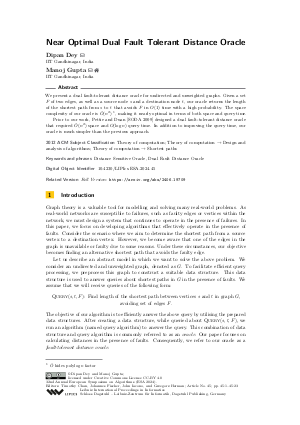Near Optimal Dual Fault Tolerant Distance Oracle
Authors Dipan Dey, Manoj Gupta
-
Part of:
Volume:
32nd Annual European Symposium on Algorithms (ESA 2024)
Part of: Series: Leibniz International Proceedings in Informatics (LIPIcs)
Part of: Conference: European Symposium on Algorithms (ESA) - License:
 Creative Commons Attribution 4.0 International license
Creative Commons Attribution 4.0 International license
- Publication Date: 2024-09-23
File

PDF
LIPIcs.ESA.2024.45.pdf
- Filesize: 0.81 MB
- 23 pages
Document Identifiers
Related Versions
- Full Version https://arxiv.org/abs/2406.19709
Subject Classification
ACM Subject Classification
- Theory of computation
- Theory of computation → Design and analysis of algorithms
- Theory of computation → Shortest paths
Keywords
- Distance Sensitive Oracle
- Dual Fault Distance Oracle
Metrics
- Access Statistics
-
Total Accesses (updated on a weekly basis)
0PDF Downloads0Metadata Views
Abstract
We present a dual fault-tolerant distance oracle for undirected and unweighted graphs. Given a set F of two edges, as well as a source node s and a destination node t, our oracle returns the length of the shortest path from s to t that avoids F in O(1) time with a high probability. The space complexity of our oracle is Õ(n²) , making it nearly optimal in terms of both space and query time. Prior to our work, Pettie and Duan [SODA 2009] designed a dual fault-tolerant distance oracle that required Õ(n²) space and O(log n) query time. In addition to improving the query time, our oracle is much simpler than the previous approach.
Cite As Get BibTex
Dipan Dey and Manoj Gupta. Near Optimal Dual Fault Tolerant Distance Oracle. In 32nd Annual European Symposium on Algorithms (ESA 2024). Leibniz International Proceedings in Informatics (LIPIcs), Volume 308, pp. 45:1-45:23, Schloss Dagstuhl – Leibniz-Zentrum für Informatik (2024)
https://doi.org/10.4230/LIPIcs.ESA.2024.45
BibTex
@InProceedings{dey_et_al:LIPIcs.ESA.2024.45,
author = {Dey, Dipan and Gupta, Manoj},
title = {{Near Optimal Dual Fault Tolerant Distance Oracle}},
booktitle = {32nd Annual European Symposium on Algorithms (ESA 2024)},
pages = {45:1--45:23},
series = {Leibniz International Proceedings in Informatics (LIPIcs)},
ISBN = {978-3-95977-338-6},
ISSN = {1868-8969},
year = {2024},
volume = {308},
editor = {Chan, Timothy and Fischer, Johannes and Iacono, John and Herman, Grzegorz},
publisher = {Schloss Dagstuhl -- Leibniz-Zentrum f{\"u}r Informatik},
address = {Dagstuhl, Germany},
URL = {https://drops.dagstuhl.de/entities/document/10.4230/LIPIcs.ESA.2024.45},
URN = {urn:nbn:de:0030-drops-211164},
doi = {10.4230/LIPIcs.ESA.2024.45},
annote = {Keywords: Distance Sensitive Oracle, Dual Fault Distance Oracle}
}
Author Details
References
-
Yehuda Afek, Anat Bremler-Barr, Haim Kaplan, Edith Cohen, and Michael Merritt. Restoration by path concatenation: fast recovery of MPLS paths. Distributed Computing, 15(4):273-283, 2002.

-
Josh Alman and Virginia Vassilevska Williams. A refined laser method and faster matrix multiplication. In Proceedings of the 2021 ACM-SIAM Symposium on Discrete Algorithms (SODA), pages 522-539. SIAM, 2021.

-
Michael A. Bender and Martin Farach-Colton. The LCA problem revisited. In LATIN 2000: Theoretical Informatics, 4th Latin American Symposium, Punta del Este, Uruguay, April 10-14, 2000, Proceedings, pages 88-94, 2000.

-
Aaron Bernstein and David Karger. A nearly optimal oracle for avoiding failed vertices and edges. In Proceedings of the forty-first annual ACM symposium on Theory of computing, pages 101-110. ACM, 2009.

-
Shiri Chechik, Sarel Cohen, Amos Fiat, and Haim Kaplan. (1 + ε)-approximate f-sensitive distance oracles. In Proceedings of the Twenty-Eighth Annual ACM-SIAM Symposium on Discrete Algorithms, SODA 2017, Barcelona, Spain, Hotel Porta Fira, January 16-19, pages 1479-1496, 2017.

-
Don Coppersmith and Shmuel Winograd. Matrix multiplication via arithmetic progressions. In Proceedings of the nineteenth annual ACM symposium on Theory of computing, pages 1-6, 1987.

-
Camil Demetrescu, Mikkel Thorup, Rezaul Alam Chowdhury, and Vijaya Ramachandran. Oracles for distances avoiding a failed node or link. SIAM J. Comput., 37(5):1299-1318, 2008.

-
Dipan Dey and Manoj Gupta. Nearly optimal fault tolerant distance oracle. arXiv preprint arXiv:2402.12832, 2024.

-
Ran Duan and Seth Pettie. Dual-failure distance and connectivity oracles. In Proceedings of the Twentieth Annual ACM-SIAM Symposium on Discrete Algorithms, SODA 2009, New York, NY, USA, January 4-6, 2009, pages 506-515, 2009.

- Ran Duan and Hanlin Ren. Maintaining exact distances under multiple edge failures. In Stefano Leonardi and Anupam Gupta, editors, STOC '22: 54th Annual ACM SIGACT Symposium on Theory of Computing, Rome, Italy, June 20 - 24, 2022, pages 1093-1101. ACM, 2022. URL: https://doi.org/10.1145/3519935.3520002.
-
François Le Gall. Powers of tensors and fast matrix multiplication. In International Symposium on Symbolic and Algebraic Computation, ISSAC '14, Kobe, Japan, July 23-25, 2014, pages 296-303, 2014.

-
Manoj Gupta and Aditi Singh. Generic single edge fault tolerant exact distance oracle. In 45th International Colloquium on Automata, Languages, and Programming, ICALP 2018, July 9-13, 2018, Prague, Czech Republic, pages 72:1-72:15, 2018.

-
John Hershberger and Subhash Suri. Vickrey prices and shortest paths: What is an edge worth? In 42nd Annual Symposium on Foundations of Computer Science, FOCS 2001, 14-17 October 2001, Las Vegas, Nevada, USA, pages 252-259, 2001.

-
Adam Karczmarz and Piotr Sankowski. Sensitivity and dynamic distance oracles via generic matrices and frobenius form. In 64th IEEE Annual Symposium on Foundations of Computer Science, FOCS 2023, Santa Cruz, CA, USA, November 6-9, 2023, 2023.

-
Merav Parter and David Peleg. Sparse fault-tolerant BFS trees. In Algorithms - ESA 2013 - 21st Annual European Symposium, Sophia Antipolis, France, September 2-4, 2013. Proceedings, pages 779-790, 2013.

-
Andrew James Stothers. On the complexity of matrix multiplication, 2010.

-
Jan van den Brand and Thatchaphol Saranurak. Sensitive distance and reachability oracles for large batch updates. In David Zuckerman, editor, 60th IEEE Annual Symposium on Foundations of Computer Science, FOCS 2019, Baltimore, Maryland, USA, November 9-12, 2019, pages 424-435. IEEE Computer Society, 2019.

- Oren Weimann and Raphael Yuster. Replacement paths and distance sensitivity oracles via fast matrix multiplication. ACM Trans. Algorithms, 9(2), March 2013. URL: https://doi.org/10.1145/2438645.2438646.
-
Virginia Vassilevska Williams. Multiplying matrices faster than coppersmith-winograd. In Proceedings of the 44th Symposium on Theory of Computing Conference, STOC 2012, New York, NY, USA, May 19 - 22, 2012, pages 887-898, 2012.

